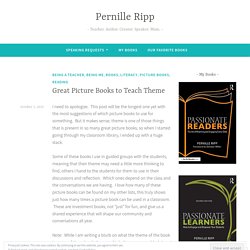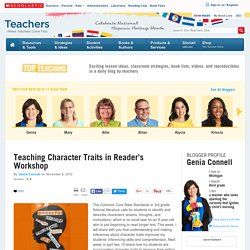

Great Picture Books to Teach Theme. I need to apologize.

This post will be the longest one yet with the most suggestions of which picture books to use for something. But it makes sense; theme is one of those things that is present in so many great picture books, so when I started going through my classroom library, I ended up with a huge stack. Some of these books I use in guided groups with the students, meaning that their theme may need a little more thinking to find, others I hand to the students for them to use in their discussions and reflection. Which ones depend on the class and the conversations we are having. I love how many of these picture books can be found on my other lists, this truly shows just how many times a picture book can be used in a classroom.
Note: While I am writing a blurb on what the theme of the book is, many of these books have multiple themes, so my blurb is not the only one. If you would like just a list without images and theme suggestion, please go here. What’s in a name? Mr. Like this: Character Traits and the Books that Teach Them - Lessons With Laughter. When I think about my goals as a teacher, character education has always been at the top of my list.

I get just as excited when my students greet other teachers by name, hold doors open for adults, and show a true sense of appreciation as when they master their multiplication facts. I believe that intelligence and character must be intertwined, and that the classroom is the perfect place to develop this. I try to integrate character education into all subjects that I teach, however I have found that it lends itself perfectly to Language Arts. There are so many wonderful children’s books that teach important values and lessons. One way that I infuse character education is discussing the theme, or “THE MEssage” of the stories we read. After reading a story, we will have one student read to us some of the previous themes we have determined as a class. Here are just a few of my favorite character traits/themes and books that I use to teach them with my class: Integrity Compassion Courage.
Using Picture Books to Teach Characterization in Writing Workshop. ReadWriteThink couldn't publish all of this great content without literacy experts to write and review for us.

If you've got lessons plans, videos, activities, or other ideas you'd like to contribute, we'd love to hear from you. More Find the latest in professional publications, learn new techniques and strategies, and find out how you can connect with other literacy professionals. More Teacher Resources by Grade Your students can save their work with Student Interactives. More Home › Classroom Resources › Lesson Plans Lesson Plan Overview Featured Resources From Theory to Practice.
Teaching Character Traits in Reader's Workshop. The Common Core State Standards in 3rd grade fictional literature calls for students to identify and describe characters’ actions, thoughts, and motivations, which is no small task for an 8-year-old who is just beginning to read longer text.

This week, I will share with you how understanding and making inferences about character traits improves my students’ inferencing skills and comprehension. Next week, in part two, I’ll share how my students are incorporating character traits to improve their writing. Introducing Character Traits Lessons on character traits are truly lessons on the comprehension skill of inferencing. Rarely does an author come out and say a character is jovial or bossy; instead, the reader must discover it by analyzing a character’s actions and dialogue. Define It For Your Students I begin by differentiating between character traits and emotions. List the Traits Make a Connection After two days, we had well over 100 traits and emotions listed on our anchor chart. Literacy Centers. Click the "References" link above to hide these references.

Daniels, H., & Bizar, M. (1998). Methods that matter: Six structures for best practice classrooms. York, ME: Stenhouse Publishers. Fountas, I., & Pinnell, G. (1996). Guided reading: Good first teaching for all children (grades K-2). Literacy Station Inspiration.